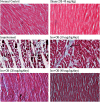Phytochemical screening and evaluation of cardioprotective activity of ethanolic extract of Ocimum basilicum L. (basil) against isoproterenol induced myocardial infarction in rats
- PMID: 23351503
- PMCID: PMC3556047
- DOI: 10.1186/2008-2231-20-87
Phytochemical screening and evaluation of cardioprotective activity of ethanolic extract of Ocimum basilicum L. (basil) against isoproterenol induced myocardial infarction in rats
Abstract
Background and the purpose of the study: The objectives of the present study were phytochemical screening and study of the effects of ethanolic extract of aerial parts of Ocimum basilicum (basil) on cardiac functions and histopathological changes in isoproterenol-induced myocardial infarction (MI).
Methods: The leaves of the plant were extracted with ethanol by maceration and subjected to colorimetry to determine flavonoids and phenolic compounds. High-performance TLC analysis and subsequent CAMAG's TLC scanning were performed to quantify rosmarinic acid content. Wistar rats were assigned to 6 groups of normal control, sham, isoproterenol, and treatment with 10, 20, and 40 mg/kg of the extract two times per day concurrent with MI induction. A subcutaneous injection of isoproterenol (100 mg/kg/day) for 2 consecutive days was used to induce MI.
Results: Phytochemical screening indicated the presence of phenolic compounds (5.36%) and flavonoids (1.86%). Rosmarinic acid was the principal phenolic compound with a 15.74% existence. The ST-segment elevation induced by isoproterenol was significantly suppressed by all doses of the extract. A severe myocardial necrosis and fibrosis with a sharp reduction in left ventricular contractility and a marked increase in left ventricular end-diastolic pressure were seen in the isoproterenol group, all of which were significantly improved by the extract treatment. In addition to in-vitro antioxidant activity, the extract significantly suppressed the elevation of malondialdehyde levels both in the serum and the myocardium.
Conclusion: The results of the study demonstrate that Ocimum basilicum strongly protected the myocardium against isoproterenol-induced infarction and suggest that the cardioprotective effects could be related to antioxidative activities.
Figures






Similar articles
-
Cardioprotective effect of methanolic extract of Marrubium vulgare L. on isoproterenol-induced acute myocardial infarction in rats.Indian J Exp Biol. 2013 Aug;51(8):653-60. Indian J Exp Biol. 2013. PMID: 24228389
-
Amelioration of inflammation by phenolic rich methanolic extract of Ocimum sanctum Linn. leaves in isoproterenol induced myocardial infarction.Indian J Exp Biol. 2015 Oct;53(10):632-40. Indian J Exp Biol. 2015. PMID: 26665293
-
Cardiopreventive effect of ethanolic extract of Date Palm Pollen against isoproterenol induced myocardial infarction in rats through the inhibition of the angiotensin-converting enzyme.Exp Toxicol Pathol. 2017 Oct 2;69(8):656-665. doi: 10.1016/j.etp.2017.06.004. Epub 2017 Jun 20. Exp Toxicol Pathol. 2017. PMID: 28645882
-
Low-temperature extracts of Purple blossoms of basil (Ocimum basilicum L.) intervened mitochondrial translocation contributes prompted apoptosis in human breast cancer cells.Biol Res. 2021 Jan 6;54(1):2. doi: 10.1186/s40659-020-00324-0. Biol Res. 2021. PMID: 33407904 Free PMC article.
-
Acute treatment with metformin improves cardiac function following isoproterenol induced myocardial infarction in rats.Pharmacol Rep. 2012;64(6):1476-84. doi: 10.1016/s1734-1140(12)70945-3. Pharmacol Rep. 2012. PMID: 23406758
Cited by
-
Jasminum sambac: A Potential Candidate for Drug Development to Cure Cardiovascular Ailments.Molecules. 2021 Sep 18;26(18):5664. doi: 10.3390/molecules26185664. Molecules. 2021. PMID: 34577135 Free PMC article.
-
Cardioprotective Potential of Plant-Derived Molecules: A Scientific and Medicinal Approach.Dose Response. 2019 May 26;17(2):1559325819852243. doi: 10.1177/1559325819852243. eCollection 2019 Apr-Jun. Dose Response. 2019. PMID: 31205459 Free PMC article. Review.
-
Exploration of Lamiaceae in Cardio Vascular Diseases and Functional Foods: Medicine as Food and Food as Medicine.Front Pharmacol. 2022 Jun 14;13:894814. doi: 10.3389/fphar.2022.894814. eCollection 2022. Front Pharmacol. 2022. PMID: 35774598 Free PMC article. Review.
-
Angiogenic effect of the aqueous extract of Cynodon dactylon on human umbilical vein endothelial cells and granulation tissue in rat.Daru. 2015 Jan 29;23(1):10. doi: 10.1186/s40199-015-0093-x. Daru. 2015. PMID: 25630338 Free PMC article.
-
Cardioprotective effects of garcinol following myocardial infarction in rats with isoproterenol-induced heart failure.AMB Express. 2020 Aug 4;10(1):137. doi: 10.1186/s13568-020-01065-9. AMB Express. 2020. PMID: 32749545 Free PMC article.
References
-
- Bunrathep S, Palanuvej C, Ruangrungsi N. Chemical compositions and antioxidative activities of essential oils from four ocimum species endemic to Thailand. J Health Res. 2007;21:201–203.
-
- Siddiqui BS, Aslam H, Ali ST, Begum S, Khatoon N. Two new triterpenoids and a steroidal glycoside from the aerial parts of Ocimum basilicum. Chem Pharm Bull(Tokyo) 2007;5:516–519. - PubMed
LinkOut - more resources
Full Text Sources
Research Materials

